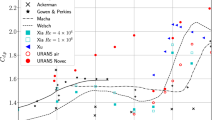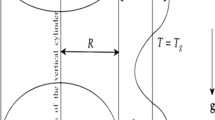Abstract
This paper deals with the effects that a thin gas layer exerts on the hydrodynamic aspects of power law liquid in a radial Couette flow between two cylinders. Analytical solution is made to determine the velocity profile in the two-phase flow system occupied by the power law liquid and the micro layer of a gas. It is shown that the thin (micro) gas layer contributes in reducing torque to set the fluid in motion in most cases. However, by considering generalized power law liquids, this paper limits the credibility for the positive role of the gas layer on reducing the torque for lubrication. For instance, when n < 0.5 (n is the behavior index of the liquid), slight increment in the torque (about 6%) is reported. Finally, energy gradient method is used for stability analysis. It is shown that the stability nature may be changed based on behavior index of the liquid.
Similar content being viewed by others
References
G. Karniadakis, A. Beskok and N. Aluru, Micro flows and nano flows: Fundamentals and simulation, Springer, New York, USA (2005).
M. Gad-el-Hak, The MEMS handbook, 2nd ed., CRC Press, New York, USA (2006).
D. C. Tretheway and C. D. Meinhart, A generating mechanism for apparent fluid slip in hydrophobic microchannels, Phys. Fluids, 16 (2004) 1509.
E. Ruckenstein and P. Rajora, On the no-slip boundary condition of hydrodynamics, J. Colloid Interface Sci., 96 (1983) 488.
Y. Zhu and S. Granick, Rate-dependent slip of Newtonian liquid at smooth surfaces, Phys. Rev. Lett., 87 (2001) 096105.
D. C. Tretheway and C. D. Meinhart, Apparent fluid slip at hydrophobic microchannel walls, Phys. Fluids, 14 (2002) L9.
Maureau J, Sharatchandra MC, Sen M and Gad-el-Hak M, Flow and load characteristics of micro bearings with slip, J. Micromech. Microeng., 7 (1997) 55–64.
K. Watanabe, T. Takayama, S. Ogata and S. Isozaki, Flow between two coaxial rotating cylinders with a highly waterrepellent wall, AIChE J., 49 (2003) 1956.
Y. B. Lee, H. D. Kwak, C. H. Kim and N. S. Lee, Numerical prediction of slip flow effect on gas-lubricated journal bearings for MEMS/MST-based micro-rotating machinery, Tribol. Int., 38 (2005) 89–96.
K. Watanabe, T. Takayama, S. Ogata and S. Isozaki, Flow between two coaxial rotating cylinders with a highly waterrepellent wall, AIChE J., 49 (2003) 1956–63.
A. Agrawal, S. V. Prabhu, Deduction of slip coefficient in slip and transition regimes from existing cylindrical Couette flow data, Exp Therm Fluid Sci., 32 (2008) 991–996.
V. A. Titarev and E. M. Shakhov, Numerical analysis of the spiral Couette flow of a rarefied gas between coaxial cylinders, Comput. Math. Math. Phys., 46 (2006) 505–13.
F. M. Sharipov, L. M. Gramani Cumin and G. M. Kremer, Transport phenomena in rotating rarefied gases, Phys. Fluids, 13 (2001) 335–46.
S. Chen and Z. Tian, Entropy generation analysis of thermal micro-Couette flows in slip regime, Int. J. Therm. Sci., 49 (2010) 2211–21.
M. Shamshiri, M. Ashrafizaadeh and E. Shirani, Advantages and disadvantages associated with introducing an extra rarefied gas layer into a rotating microsystem filled with a liquid lubricant: First and second law analyses, Energy, 45 (2012) 716–728.
L. M. Jiji and A. H. Danesh-Yazdi, Flow and heat transfer in a micro-cylindrical gas liquid Couette flow, Int. J. Heat Mass Transf., 54 (2011) 2913–20.
M. Shamshiri, M. Ashrafizaadeh and E. Shirani, Rarefaction and dissipation effects on transport phenomena associated with an immiscible two-phase flow within a shafthousing micro configuration, International Journal of Heat and Mass Transfer, 55 (2012) 4996–5006.
G. I. Taylor, Stability of a viscous liquid contained between two rotating cylinders, Phil. Trans. R. Soc. London Ser., 223 (1923) 289.
P. Sinha and D. Prasad, Lubrication of rollers by power law fluids considering consistency-variation with pressure and temperature, Acta Mechanica, 111 (1995) 223–239.
L. L. Ferrás, J. M. Nóbrega and F. T. Pinho, Analytical solutions for Newtonian and inelastic non-Newtonian flows with wall slip, Journal of Non-Newtonian Fluid Mechanics, 175–176 (2012) 76–88.
F. Caton, Linear stability of circular Couette flow of inelastic viscoplastic fluids, J. Non-Newtonian Fluid Mech., 134 (2006) 148–154.
S. J. Muller, R. G. Larson and E. S. G. Shaqfeh, A purely elastic transition in Taylor-Couette flow, Rheol. Acta., 28 (1989) 499.
N. Schaeffer and P. Cardin, Quasigeostrophic model of the instabilities of the Stewartson layer in flat and depth-varying containers, Phys. Fluids, 17 (2005) 104–111.
B. Alibenyahia, C. Lemaitre, C. Nouar and N. Ait-Messaoudene, Revisiting the stability of circular Couette flow of shear-thinning fluids, Journal of Non-Newtonian Fluid Mechanics, 183–184 (2012) 37–51.
H. S. Dou, Mechanism of flow instability and transition to turbulence, International Journal of Non-Linear Mechanics, 41 (May 2006) 512–517.
H. S. Dou, Physics of flow instability and turbulent transition in shear flows, International Journal of Physical Science, 6(6) March (2011) 1411–1425.
H. S. Dou, B. C. Khoo and K. S. Yeo, Instability of Taylor-Couette flow between concentric rotating cylinders, Int. J. Therm. Sci., 47 (2008) 1422–1435.
Author information
Authors and Affiliations
Corresponding author
Additional information
Recommended by Associate Editor Donghyun You
Seyed Salman Nourazar received his Ph.D. from Ottawa University in Canada. He is acting now as associate professor in the Mechanical Engineering Department of Amirkabir University of Technology. His research interests are the CFD in compressible and incomepressible turbulent nonreactive flows as well as rarefied gas dynamics.
Rights and permissions
About this article
Cite this article
Hajmohammadi, M.R., Salman Nourazar, S. & Campo, A. Analytical solution for two-phase flow between two rotating cylinders filled with power law liquid and a micro layer of gas. J Mech Sci Technol 28, 1849–1854 (2014). https://doi.org/10.1007/s12206-014-0332-y
Received:
Revised:
Accepted:
Published:
Issue Date:
DOI: https://doi.org/10.1007/s12206-014-0332-y




